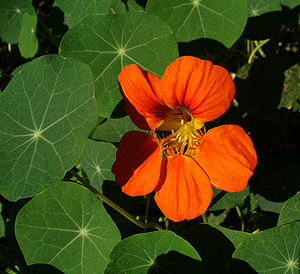
- Image via Wikipedia –Tropaeolum majus
Nasturtium is a beautiful flowering plant, Tropaeolum majus, grown for its unique foliage and edible flowers. Native to South America it’s an annual member of the Tropaeolaceae family. Nasturtium is a common name for this plant that shouldn’t be confused with the unrelated watercress of the genus Nasturtium in the mustard family. Other common names are garden nasturtium and Indian cress.
Flowers are large and come in fruity colors of red, orange and yellow. They attract hummingbirds and butterflies and bloom all summer long until an autumn frost kills the plant. The leaves are fairly round and have the stem attached in the middle underneath, so the leaves look like tiny umbrellas. The leaf veins are like spokes of a wheel that originate in the center at the leaf stem and radiate out to the wavy leaf edge.
Leaves and stems are excellent eaten fresh in leafy green salads and sandwiches. They have a peppery mustard flavor similar to watercress, and maybe even more pungent. Chopped leaves can be mixed in omelets, mayonnaise-based salads, egg dishes, pasta and vegetable dishes.
Nasturtium flowers make a spicy colorful vinegar. Pick five flowers of a similar color and steep in white vinegar for a couple of weeks. Use the colored vinegar with olive oil to splash on greens or as an accent in other types of salads.
Flowers make a beautiful and colorful garnish for plates, floated on chilled soups or shredded and sprinkled on rice dishes. Crystallize the flowers for dessert toppings or cake decorations. The fresh flowers will wilt eventually, so crystallizing them in sugar will make them last. Beat an egg white, no yolk, and dip blossoms that have been washed and patted dry into beaten egg. Alternatively, use a small paint brush to brush the egg white on each petal. Lay on parchment paper, aluminum foil or wax paper and sprinkle generously with sugar. Let dry and gently transfer to a covered container until needed for decorating.
The seeds are pickled and used as a substitute for capers. After the flowers fall away, pick the half-ripened seed pods that are still green and drop them into white wine or rice vinegar. Flavor a pint of vinegar with one tablespoon pickling spice or one teaspoon dill seed, a thin slice of onion, two peppercorns and a garlic clove. Collect seeds throughout the growing season and by autumn there will be a sizable harvest. These substitute capers are excellent with salmon and other fish dishes.
Nasturtium tea is used in Peru by native people for coughs, colds and the flu. Tea is made by bruising two or three leaves and steeping in near boiling water for ten minutes. It’s used as folk medicine to treat digestive problems, scurvy, menstrual problems and respiratory troubles. Science verifies the antibiotic, antiseptic and expectorant properties. Either the tea is consumed three times a day or three fresh leaves are eaten to substitute for the tea.

Thanks! On a seed free Autoimmune diet and am looking for pepper substitutes!
That’s great, Laine!
Let us know how you like it. 🙂